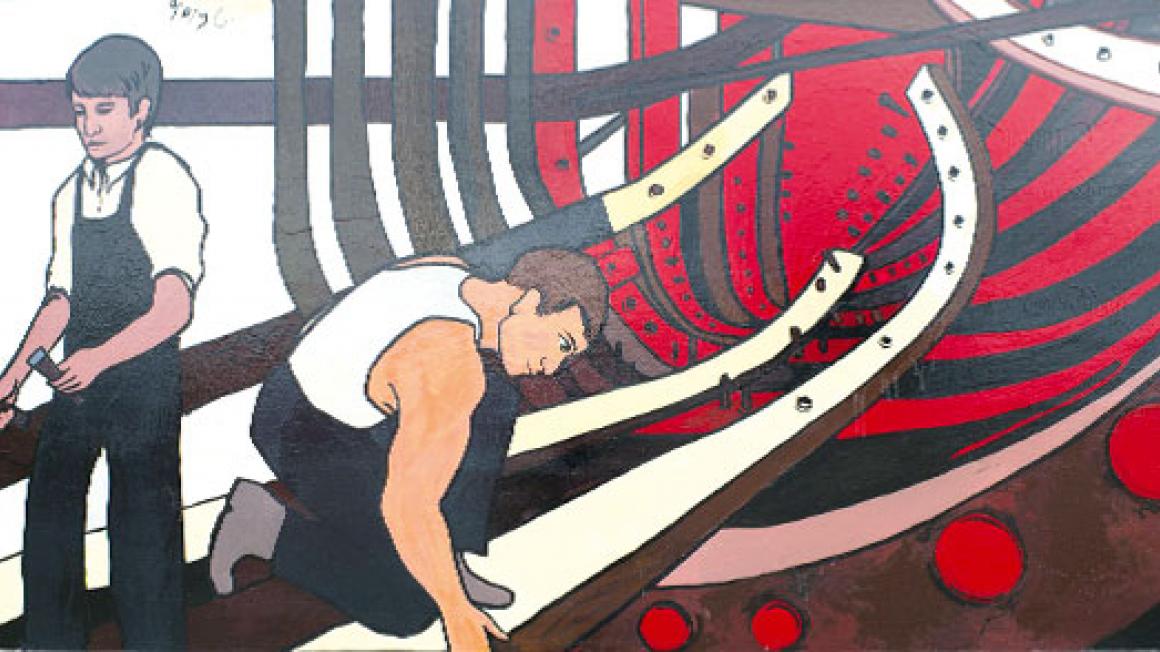The Mayflower comes home
Remarkably, my father, Richard, was among those ‘Pilgrim Fathers’ who established the Plymouth colony in 1620. Or at least his namesake was. Richard Warren was a London merchant, who left his wife and five daughters behind in England to escape religious persecution by King James and make a leap of faith most of us today could barely imagine. He seems to have been a key member of the party, too, for his name – the 13th down – appears on the Mayflower Compact, the document signed by 41 of the passengers to establish a government for their new colony.
 The original Mayflower was built in Harwich, where plaques depict the story
The original Mayflower was built in Harwich, where plaques depict the storyOf course, I have not a tot of proof that I am related to that earlier, pioneering Warren, but I wish I did. The Mayflower voyage is one of the great origins stories, a tale of idealism, new beginnings and the birth of a nation. Little wonder, then, that so many people feel a bond to it. In the United States alone, a staggering 35 million people claim to be descended from a Mayflower passenger.
Modern England, too, is dotted with Mayflower streets, centres, cafes. Like the Titanic, the Cutty Sark and the Mary Rose, her name is indelibly engraved on the nation’s memory. And now, at the end of a railway line in Harwich, she is being rebuilt, one intricately honed timber at a time.
 Left: Sean Day, co-founder of the project, with Matt. Right: It’s a tough job, but someone has to do it
Left: Sean Day, co-founder of the project, with Matt. Right: It’s a tough job, but someone has to do itI arrive at the Harwich Mayflower Project’s Portakabin headquarters in the jaws of a spring squall – Mayflower weather, I’d imagine. And in this light, at least, the site looks rather bleak. An old railway yard – the line still serves an hourly Mayflower Express service from Manningtree – it is littered with aggregate rubble, piles of timber and unnerving-looking machinery (although it is also home to Harwich’s oldest letter box, painted blue).
‘We were given this bit,’ says gregarious co-founder Sean Day, pointing to a grassy area in front of the station, ‘because the only return the owner was getting was from the washing machines being fly-tipped over the fence.’
But first impressions can be deceptive. Look and listen more closely and this oft-overlooked corner of Essex is the setting for a truly remarkable modern-day yarn of craftsmanship, regeneration and bloody-minded British determination. Think the Mayflower, and Plymouth, where it took on many of its passengers, is often the first place that springs to mind. But the ship was built here in Harwich, ‘within a seagull’s flight of this site’. Her captain Christopher Jones was also a Harwich resident and his house still stands, just 200 yards away, a lucky survivor of the German bombs that fell on the town during the war.
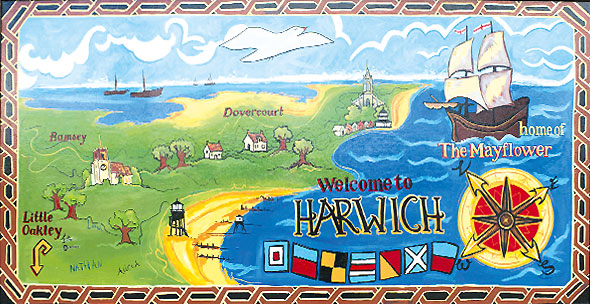
The town has been behind some other, quirkier, maritime creations, too. In 1956, when a vast model whale was needed for the film Moby Dick, starring Gregory Peck, David Budworth – father of The Lady’s owner, Ben, who had a turbine factory in Harwich – came to the rescue, building the beast, which was then covered in Dunlop rubber. Indeed, if you’re going to rebuild the Mayflower – the original was broken up at Rotherhithe in 1623 – Harwich really is the place to do it.
But it was another ship altogether that first got the ball rolling. ‘A replica of Captain Cook’s Endeavour visited Harwich a few years back and the visitors flooded in,’ says Sean.
‘Immediately, we could see the potential.’
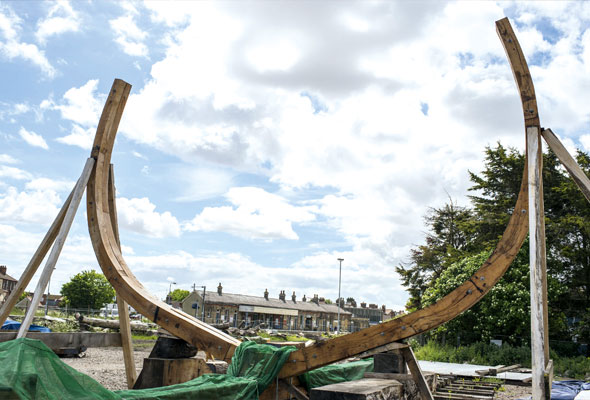 The ship’s hull is slowly taking shape
The ship’s hull is slowly taking shapeThe Mayflower Project was born in 2009, when early meetings were hosted in the waiting room of chairman Tom Daly’s dental surgery. ‘Now, of course, we have other premises where we can meet without the background sound of drills and screaming,’ laughs Sean. Indeed, they have since taken over the redundant station buildings, and have completely refurbished the old rail shed, where apprentices are trained and the finer construction work can be done away from the angry North Sea weather.
And at the heart of the site, they also have a ship. Well, the beginnings of one anyway. No one knows exactly what the Mayflower looked like, but plans have been drawn up by famous marine architects, Westbrook, and work is underway. The new Mayflower’s keel is down, and the sternpost is up. Frame 20 (one of the ship’s huge ribs) is also in place. The bow stem will soon be done. There’s a long way to go, but she is already a thing of beauty.

Part of the magic is that she isn’t emerging out of a mould or a machine, but is being crafted from the vast English oak trees now stacked up around the site, many of which have a colourful tale of their own. ‘We flew down to Cornwall and Lord Falmouth sold us 250 trees for a very low rate,’ Sean tells me. ‘What he didn’t tell us was that half of them were hanging out of cliff faces and ravines. I had to organise another working group of climbing tree surgeons just to extract them all. The Royal Navy was then going to ship it for us as part of a PR exercise, but then something happened in the Middle East so we had to hire fleets of lorries instead. There’s an awful lot of wheeling and dealing.’
Currently, they have 25 per cent of the timber they need to build the Mayflower – ‘Yes, it’s all English oak,’ laughs Sean. ‘We’ve had offers of continental wood, but we’re being very purist’ – but there are always hidden problems. ‘The thing about working with wood is that it’s a natural product. You don’t know what you’ve got until you cut into it. You might just have a load of earwigs, or should I say Forficula auricularia?’
 An engraving of pilgrims embarking for the colonies
An engraving of pilgrims embarking for the coloniesWhat they are short of, however, is bronze. Silicone bronze, to be precise Nearly £500,000-worth of silicone bronze fastenings are now needed to finish the hull, and members of the public are being asked to donate one of the numbered items for 60 euros. ‘In future, they’ll be able to look at an online model of the ship, which will show them exactly where their donated item went,’ says Sean.
All being well, in 2017 the biggest crane in the UK will lift the 182 tons of watertight hull out of the yard and across the road into Gas House Creek, where the masts will be added. And by 2020 Sean is determined that the Mayflower will be ready to recreate the original’s voyage to mark its 400th anniversary. It will then serve as a tourist attraction – bringing jobs, visitors and development to the area – and a unique deep-sea training vessel for aspiring sailors from all back- grounds. In short, it will be a big boon for Britain.
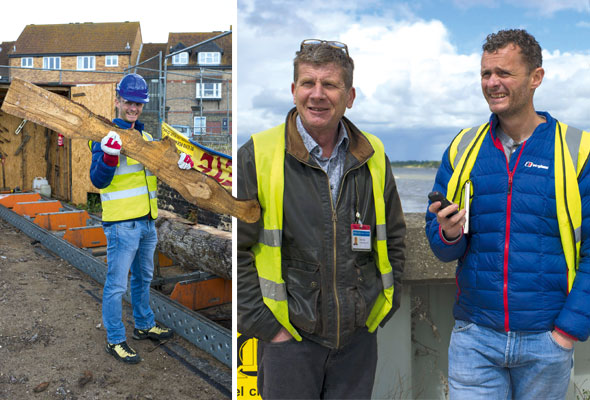 Matt gets to grips with a length of real oak timber.
Matt gets to grips with a length of real oak timber. But there’s an awful lot of work ahead, not least raising the £4.1m required to build the Mayflower and regenerate the surrounding area. Supporter Richard Branson (Sean collared him when he discovered they were staying in the same hotel) has called The Harwich Mayflower Project ‘The charity to watch’, but no ship gets built without cold hard cash.
‘That’s the bottom line,’ says Sean.
So I offer to do my part, don a hard hat, reflective tabard and requisite pair of safety goggles and indulge in a little hard labour. Ashley, one of the passionate specialist builders, introduces me to the band saw – and you can tell he really likes it. It’s a monstrous thing that cuts through timber like a razor through dough. ‘It came in bits in a crate, like something out of Ikea,’ says Ashley. ‘It took me three weeks to build. But it’s a beautiful machine.
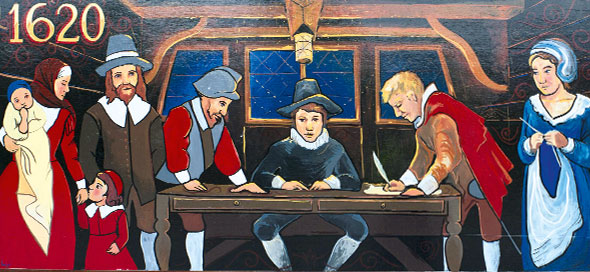 The Mayflower Compact set up a government for the new colony
The Mayflower Compact set up a government for the new colony‘Just don’t stand anywhere out here,’ he adds, waving out a broad arc in front of the saw. ‘If the blade snaps it could fly out and take your head off.’
No pressure, then. In front of me is a 30-foot long oak tree trunk and yet the saw shaves off a perfectly straight ¼in-thick plank as if it were grating a slither of Parmesan cheese.
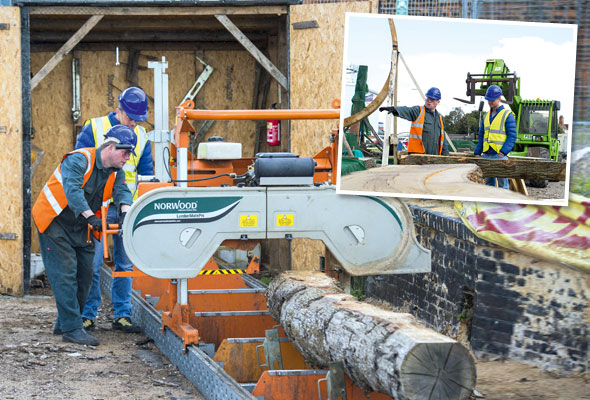
Four hundred years ago, they would have had to have made this devilishly difficult precision cut using a two-man saw and an awful lot of grunt. But they didn’t have so many health and safety regulations to worry about then, either. While the new Mayflower is being built using good old-fashioned craftsmanship, it must also comply with 21st-century regulations.
‘This Mayflower will have two engines, for example,’ says Sean. ‘Just in case.’
 A CGI model of what the hull will look like
A CGI model of what the hull will look likeOn the 75th anniversary of Dunkirk, the spirit of that great British venture remains alive and well. At least here. The project faces formidable challenges over the next few years and needs all the support it can get. But as we lunch on fish and chips at the nearby Pier Hotel, with views out across the steel grey North Sea, I wouldn’t be the slightest bit surprised if a certain ship sailed by. The Mayflower is coming home.
For more details or to donate to the Harwich Mayflower Project: 01255- 318023, www.harwichmayflower.com


